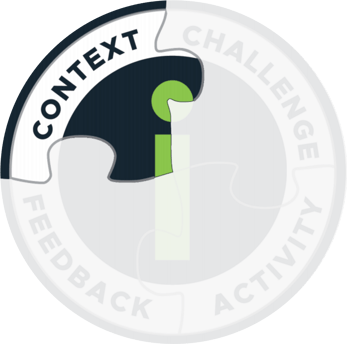Blog
Unlocking The Power of CONTEXT in e-Learning Design
Context con·text | känˌtekst | noun 1. The circumstances that form the setting for an event, statement, or idea, and in terms of which it can be ...


Pillar I for Transformative e-Learning Instructional Design: Context
By Ethan Edwards | February 19, 2021 | Custom Learning | 1 Comment
Context
con·text | känˌtekst | noun
1. The circumstances that form the setting for an event, statement, or idea, and in terms of which it can be fully understood and assessed.
Such a simple word.
Context holds power in creating e-learning instructional designs that work.
Context is a critical component of the CCAF Design Model (Context-Challenge-Activity-Feedback) for instructional interactivity created by Michael Allen. It’s all too easy to focus solely on getting the content “right” when embarking on an e-learning instructional design project. Hours upon hours are spent staging content from subject matter experts and wordsmithing paragraphs of text to pass legal standards. Of course, content is significant. This approach only makes sense if we think training is just about communicating facts.
Meaningful Context is often overlooked in corporate training solutions
In reality, training is about communicating meaning, and meaning is conveyed by far more than simple facts. We find richness and meaning in communication through context as much as the literal words on the screen. We use our eyes to process visual cues, our prior experiences activate existing mental models, and emotions trigger connections that foster long-term memories. In other words, the broader Context in which we encounter information has an enormous impact on how we learn.
There is always Context, but I’m afraid its very ordinariness causes context to be too often overlooked in what instructional design needs to provide for effective learning. Even the blandest context-free content presentation becomes a context, albeit a boring one—a neutral or academic context that generally impedes the transfer of meaning. Too often I see traditional contexts used largely by default or habit.
For example, a “book-like page-turning” structure may provide a navigation skeleton but, at the same time, conveys a monotonous impact that blends with every other piece of learning. Or there’s the standardized question model that only reminds the learner that the matter at hand is no more significant to them than the hundreds of versions of the same question they have already answered.
Context is every bit as important as the thinking that goes into the other aspects of instructional interactivity.
Context can:
- be completely visual, establishing relevance by creating an environment of meaning in which the lesson activities reside
- be narrative in nature, letting story elements create interest, suspense, recognition, etc.
- bring emotion, representing human feelings and identities through media and personality to create a bond with the learner
- provide structure in a way that encourages practice and repetition that might be otherwise difficult to achieve
- create a gaming environment that enhances motivation and entertainment while also achieving some of the aforementioned possibilities
These are just a few of the many ways your design choices can define context.
Recognizing the importance of Context is just the first step
How do you come up with the right Context? First off, there is no single right context. There are many great Contexts for a particular challenge, and there are also many poor ones—the key to coming up with a powerful Context comes from what you learn from analysis:
- What are the desired performance outcomes?
- What is the performance environment like?
- What are the conditions for success?
- What kinds of errors get in the way of learner success?
The answers to these questions are the starting point for figuring out an appropriate and powerful Context for your e-learning instructional designs. Once a direction is identified, you can use narrative voice, visual style, narrative arc, mood, and other communication choices to build convincing, and even irresistible, contexts which will result in lasting learning and performance change.
If these are the kinds of e-learning design questions you struggle with, join me for the first in a four-part series where we take a quick look into the four components of Instructional Interactivity:
- CONTEXT
- CHALLENGE
- ACTIVITY
- FEEDBACK
The 4 Pillars to Transformative e-Learning Digital Learning Series is on-demand, and I’ll guide participants through some of the primary considerations in designing context to take taking full advantage of its role in creating effective e-learning interactions. We’ll explore in more detail the various ways it can create immediate meaning and value in your e-learning courses. We’ll further explore the power of designing a compelling context and share some pointers for your own design thinking. As usual, we'll look at some real-world e-learning examples to see how this thinking results in stellar e-learning.
5 critical ways that Context can be manifested to empower learning
Context can...
1. be completely visual
Establishing relevance by creating an environment of meaning in which the lesson activities reside.
2. be narrative
Letting story elements create interest, suspense, recognition, etc.
3. bring emotion
Representing human feelings and identities through media and personality to create a bond with the learner.
4. provide structure
In a way that encourages practice and repetition that might be otherwise difficult to achieve.
5. create a gaming environment
That enhances motivation and entertainment while also achieving some of the aforementioned possibilities.
Read More
Pillar II Blog: Challenge
Pillar III Blog: Activity
Pillar IV Blog: Feedback
Download your exclusive copy of the 4 Pillars Playbook to create interactive e-learning instructional designs!

About the Author: Ethan Edwards
Ethan Edwards draws from more than 30 years of industry experience as an elearning instructional designer and developer. He is responsible for the delivery of the internal and external training and communications that reflect Allen Interactions’ unique perspective on creating Meaningful, Memorable, and Motivational learning solutions backed by the best instructional design and latest technologies.
Comments
Thanks sir! for sharing your information!
Would you like to leave a comment?
Related Blog Posts

By: Ethan Edwards | Mar, 2014
Category: Custom Learning

Blog
Pillar IV for Transformative e-Learning Instructional Design: Feedback
Context con·text | känˌtekst | noun 1. The circumstances that form the setting for an event, statement, or idea, and in terms of which it can be ...
By: Ethan Edwards | Mar, 2021
Category: Custom Learning

Blog
Pillar III for Transformative e-Learning Instructional Design: Activity
Context con·text | känˌtekst | noun 1. The circumstances that form the setting for an event, statement, or idea, and in terms of which it can be ...
By: Ethan Edwards | Mar, 2021
Category: Custom Learning



jerry miller
4/8/2021, 9:12 AM